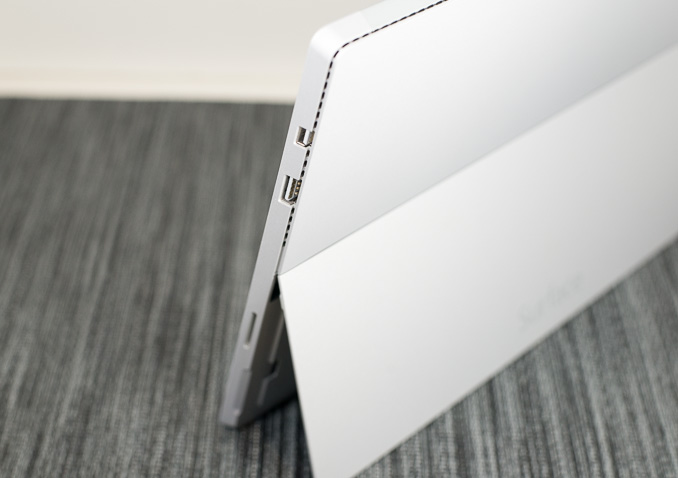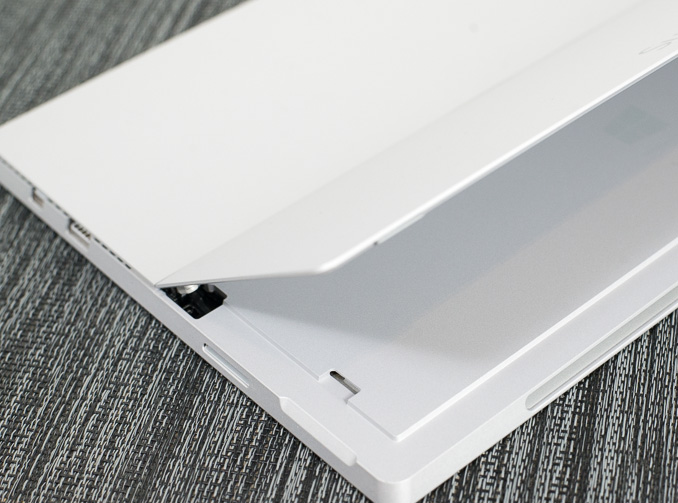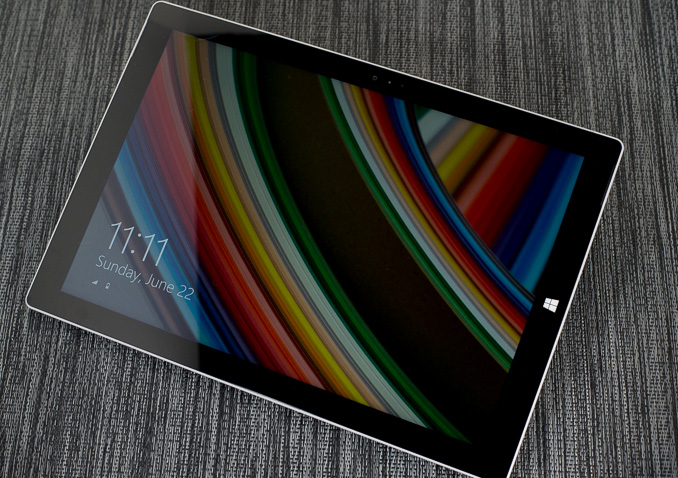Microsoft Surface Pro 3 Review
by Anand Lal Shimpi on June 23, 2014 3:55 AM ESTFinal Words
When I reviewed the first Surface Pro I was intrigued by the idea, but felt it needed a few more iterations to get to the right point. In less than two years what we have in front of us looks very different than Microsoft's original vision for the platform. Display size, aspect ratio and even the mechanics of the whole thing are all quite different. The changes are for the better as Surface Pro 3 is a much better laptop and a much better tablet than any of its predecessors. The device no longer feels cramped and tiring to use as a laptop. The new Surface Pro no longer feels heavy to use as a tablet either. It's truly an improvement on both vectors.
Microsoft might be overselling the design to say that it truly is the only device you need. Like most compromises, Surface Pro 3 isn't the world's best laptop nor is it the world's best tablet. It serves a user who wants a little of column A and a little of column B.
The device's "lapability" is tremendously better than any of its predecessors. While I wrote all of the previous Surface reviews on the very Surface devices I was reviewing, this is by far the most comfortable one to use as a laptop. It's still not perfect, and you still need a fairly long lap to make it work, but the design is finally really usable as a laptop.
As a tablet the thinner and lighter chassis is much appreciated. The new kickstand remains one of the best parts of the design, enabling a flexibility unmatched by any other tablet. Tent mode in particular is awesome for tablet usage models.
Surprisingly enough the move away from Wacom to an active NTrig pen model comes with very few issues. The device could use some tuning of its pen pressure curves. Applying max pressure on the screen now distorts the LCD, something I'm never comfortable doing. But overall the new pen gives up very little and even improves performance and functionality.
The new Type Cover is awesome. The keyboard is probably as good as it's going to get, and the new trackpad is finally usable. The latter isn't perfect but it's so much better than anything that's come before it.
The device also launches with a far more polished version of Windows. With its latest updates, Windows 8.1 is a far cry from where it first started. I still think there's lots of room for improvement, but it's clear that Microsoft is marching towards a more cohesive vision of modern and desktop Windows UIs.
The downsides for Surface Pro 3 are obvious. Windows 8.1 remains a better desktop/notebook OS than a tablet OS. Yet in a device like Surface Pro 3 where you're forced to rely on touch more thanks to a cramped trackpad, I'm often in a situation where I'm interacting with the Windows desktop using the touchscreen - a situation that rarely ends well. As Microsoft improves the behavior of its modern UI apps, I would love to see a rethinking of what touch looks like on the desktop. If Surface Pro 3 exists to blur the lines between laptop and tablet, Windows 9 needs to do a better job of the same. The desktop needs to react better to touch and the modern apps need to feel even more integrated into the desktop.
On the hardware side, the device is a compromise. You have to be willing to give up some "lapability" in order to get a unified laptop/tablet device. Whether what you get as a tablet is worth the tradeoff is going to be up to how good of a tablet OS Windows 8.1 is for you. Personally I find that Android and iOS deliver better tablet experiences particularly when it comes to 3rd party applications. If everything you need on the tablet front is available in the Windows Store however then the point is moot.
Those users upgrading from Surface Pro 2 may notice a regression in performance, particularly when it comes to running prolonged CPU/GPU intensive workloads. In games, the difference can be noticeable. The simple fact is that in becoming a thinner device, Surface Pro 3 inherited more thermal constraints than its predecessors. While performance regressions aren't ideal, in this case I can appreciate what Microsoft has done. From the very beginning I wanted a lower TDP part in a thinner chassis. Had Microsoft done that from the start we wouldn't have seen any performance regression but rather a steady increase over time. From my perspective, Surface Pro 3 is simply arriving at the right balance of thermals and performance - the previous designs aimed too high on the performance curve and required an unreasonably large chassis as a result.
The remaining nitpicks are the same as last time: Microsoft needs to embrace Thunderbolt, and a Type Cover should come with the device. The display's color accuracy is good but grayscale performance needs some work.
Surface Pro 3 is easily the best design Microsoft has put forward. If you were intrigued by the previous designs, this is the first one that should really tempt you over. I was a fan of the original Surface Pro, and with Surface Pro 3 I think Microsoft has taken the hardware much closer to perfection. At this point the design needs more help on the software side than hardware, which is saying a lot for the Surface Pro hardware team. Personally I'd still rather carry a good notebook and a lightweight tablet, but if you are looking for a single device this is literally the only thing on the market that's worth considering. I don't know how big the professional productivity tablet market is, but it's a space that Microsoft seems to have almost exclusive reign over with its Surface line. With its latest iteration, Microsoft is serving that market better than ever.













274 Comments
View All Comments
kyuu - Monday, June 23, 2014 - link
Problem with the rigid keyboard attachment ala the Transformer is that it only works when you have the keyboard attached. If you want to use it just as a tablet, you suddenly have no way to prop the device. It also adds much more weight and bulk.It does seem like it'd be a good idea to offer something like that as an optional attachment, especially since they insist on continuing to package and sell the type cover as an add-on.
ymcpa - Monday, June 23, 2014 - link
The only way the transformer solution works is if you have a battery in the keyboard dock that is heavy enough to support the tablet. Now you have a very heavy device, although with much longer battery life. Maybe they can introduce this as an accessory to replace the battery cover for people like you that don't care about weight.waverlybrian - Friday, June 27, 2014 - link
I don't think it's such a bad idea. Most people have some sort of kick-stand option for their iPad, which are not as good as this one. However, I do understand that you're coming from the laptop perspective. In that case I agree that MS should have partnered with a 3rd party like Logitech to come out with the heavier rigid keyboard attachment. That would have made the laptop replacement aspect of the SP3 truly complete (and given them a better reason to not include the Type Cover with the PC). With a small battery and a few ports in the base, this would really address all of the complaints from reviews that this doesn't measure up to the MBA.hughlle - Friday, June 27, 2014 - link
Yet for tablet use, the kickstand is absolutely fantastic. To hell with flimsy and unstable 2 position case stands for tablets. I'll take a kick stand any day of the week.mkozakewich - Monday, June 30, 2014 - link
I use the Surface (original) on both legs or one leg, and have never generally had problems with it.There's the rare time where I'm laying down with my knees up, and will have the tablet against my knees held up by the keyboard in my lap pressing against my stomach, and in that case I could use a bit more firmness in the link between Surface and cover, but that has nothing to do with the kickstand.
Megabusta - Monday, June 23, 2014 - link
First time poster, long time lurker. Lovely review as always. I wish I could wait for the broadwell refresh but my gigantor ASUS G73JH's GPU just bit the dust from overheating constantly and I'll be picking one of these next payday. The student discount doesn't hurt either. I don't need a portable gaming machine anymore and the design of the laptop looked a little goofy when brought into work. Going from that 8.5 lb behemoth to this 2 lb thing is going to be a big change but a welcome one for my back and shoulders.iceman-sven - Monday, June 23, 2014 - link
Nice review Anand.The Surface is pretty near, what I want. But for a workable config is to expensive for me. Or I want more for that money.
By the end of the year, we will see the first 4k tablets. So 2160 x 1440 is a little bit low for the future. I get this is mostly a Intel fault, for a bad road-map. The first good chip is properly Skylake-U.
Other missed opportunities: PCIe SSD & Thunderbolt
My next tablet is a 12-13" 4k Nvidia Tegra K1 ARMv8 or iPad Pro.
jeffkibuule - Monday, June 23, 2014 - link
You need to be careful wishing for 4K everything, because while you're eyes might not notice the screen resolution increase, your CPU, GPU and screen backlight are going to take a sizable hit to your battery life.iceman-sven - Monday, June 23, 2014 - link
I do not care, it is for more than 80% home use. So power is near by.joaoasousa - Tuesday, June 24, 2014 - link
I mostly use my tablet at home and I still cherish the fact that I don't have to keep it plugged.....